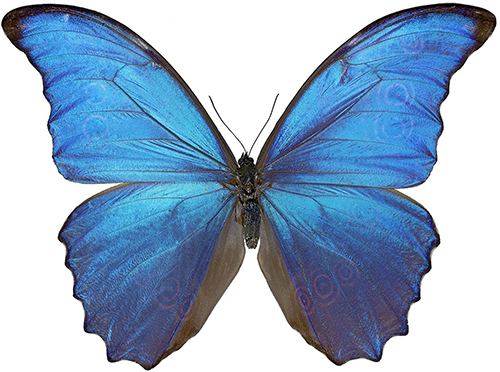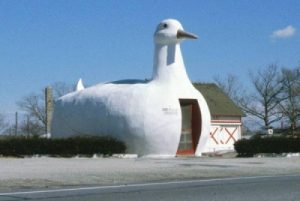biomimicry
Content
 Goal: Understand how you can get inspiration from nature to improve sustainability, including inspiration from biological mentors and from general principles of nature.
Goal: Understand how you can get inspiration from nature to improve sustainability, including inspiration from biological mentors and from general principles of nature.

Morpho butterflies have inspired products from paints to textiles to computer monitors.
(Image from Wikimedia Commons.)
.
Biomimicry takes inspiration from nature to find better ways of making or doing things. Biomimicry can work at any scale, from self-cleaning paint that mimics the micro-structure of a lotus flower, to an office tower that mimics a termite mound’s ventilation structure to passively cool itself.
.
What Biomimicry Is and Is Not
Biomimicry is a rich and engaging form of design-by-analogy to get new perspectives on solving problems. For example, Velcro was inspired by burrs from wild grasses sticking to a dog’s fur–tiny hooks on one strip of Velcro act like burrs, catching the fur-like loops on the matching strip.
Burrs on dog fur, and Velcro. (Images from Shutterstock and Velcro.com.)
.
Biomimicry, when done well, is not slavish imitation of nature, nor is it necessarily using natural materials like wood or mycelium. Instead, it is using the principles which nature uses. It is also not merely about aesthetics, it is about function. A building shaped like a duck may be entertaining, but it is not properly biomimetic unless it also derives some useful function from the shape (such as being more energy efficient, or waterproof, etc.) The Velcro described above does not look like a burr or like a dog, yet it perfectly recreates their physics to provide strong adhesion.
 Aesthetics are not meaningful biomimicry. (Image from Wikimedia commons.)
Aesthetics are not meaningful biomimicry. (Image from Wikimedia commons.)
.
Biomimicry can work at the levels of form, or process, or system, according to Janine Benyus’s book “Biomimicry“. For example, Velcro imitates the physical form of burrs and fur, but it is not manufactured by planting seeds in soil and waiting for them to grow. If it were, that would be a biomimetic process. This is where using biological materials like Ecovative‘s mycelium packaging can enable biomimicry. Velcro is also not usually recovered at its end of life to become food for some other product manufacturing. If it were, such connections between products and processes would be a biomimetic system like Interface‘s 100% recycled carpet tiles, or like the Cradle to Cradle concepts of technical nutrients and biological nutrients.
Biomimicry can be used for any kind of design or engineering, not just for sustainability; in fact, historically, most applications have been in robotics and medical devices, due to the greater funding in those fields. However, biomimicry is an excellent frame of mind for sustainability, because how better to work in harmony with nature than to design and build things the way nature does?
.
.
Doing Biomimicry
There are two basic ways get new ideas through biomimicry. Follow the links below for descriptions, exercises, and examples:
Biomimicry from mentors is when you seek inspiration from specific organisms, whether you do it physically in the wild, or in published resources such as the AskNature.org database or books or scientific literature.
Biomimicry from principles is when you seek inspiration from general principles of how nature works. Multiple people have identified lists of such principles over the years that you can brainstorm from.
.
.
Resources:
- Biomimicry, by Janine Benyus (the book that started the modern biomimicry movement)
- Nature Inspired Design, by Erik Templeman, Bram van der Grinten, Ernst-Jan Mul, Ingrid de Pauw (a practical guide)
- The Way Nature Works, edited by Robin Rees (one of many nature picture-books that are good for finding ideas)
- Cats’ Paws and Catapults, by Steven Vogel (an excellent source of mechanical engineering-related biomimicry)
- On Growth and Form, by D’arcy Thompson (both a giant tome of scientific theory and a good sourcebook of images)
- Out of Control, by Kevin Kelly (an inspiring book of systems design theory)
- Life in Moving Fluids, by Steven Vogel (a biomimetic fluid dynamics textbook)
- Structural Biomaterials, by Julian Vincent (a materials science analysis of natural materials)
- Biomimicry for Optimization, Control and Automation, by Kevin Passino (a computer science textbook on genetic algorithms, neural networks, etc.)
- Zygote Quarterly, by many authors (a magazine of bio-inspired case studies and interviews)
.
All VentureWell Tools for Design and Sustainability content is shareable and usable by CC BY-NC-SA 4.0 license.